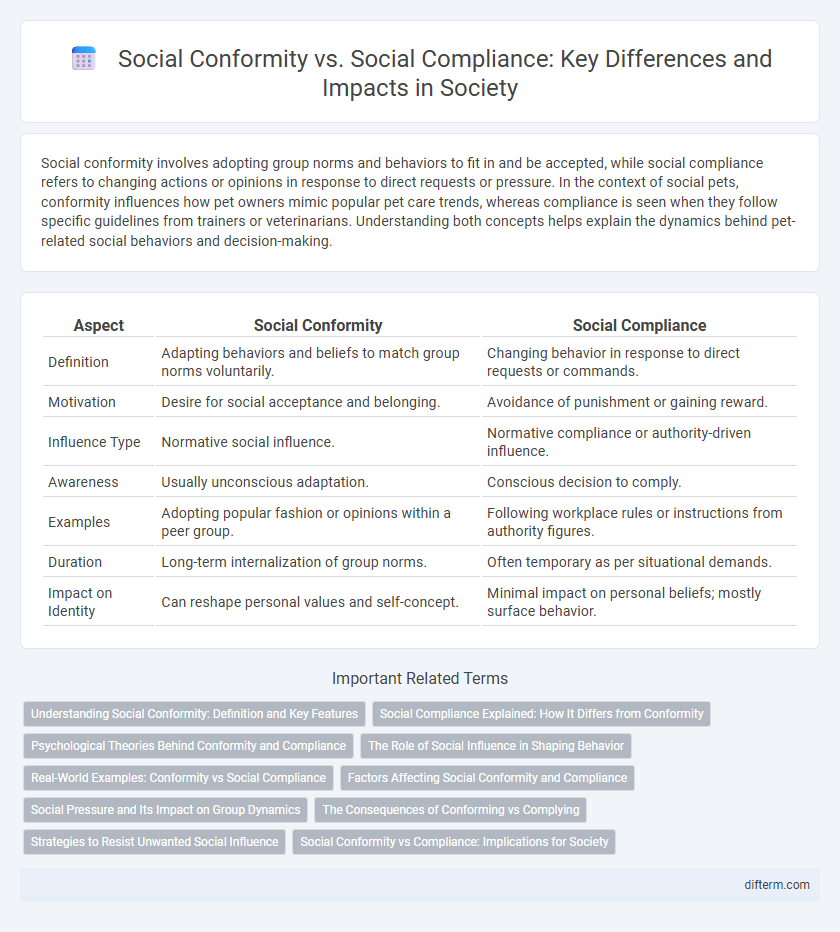Social conformity involves adopting group norms and behaviors to fit in and be accepted, while social compliance refers to changing actions or opinions in response to direct requests or pressure. In the context of social pets, conformity influences how pet owners mimic popular pet care trends, whereas compliance is seen when they follow specific guidelines from trainers or veterinarians. Understanding both concepts helps explain the dynamics behind pet-related social behaviors and decision-making.
Table of Comparison
| Aspect | Social Conformity | Social Compliance |
|---|---|---|
| Definition | Adapting behaviors and beliefs to match group norms voluntarily. | Changing behavior in response to direct requests or commands. |
| Motivation | Desire for social acceptance and belonging. | Avoidance of punishment or gaining reward. |
| Influence Type | Normative social influence. | Normative compliance or authority-driven influence. |
| Awareness | Usually unconscious adaptation. | Conscious decision to comply. |
| Examples | Adopting popular fashion or opinions within a peer group. | Following workplace rules or instructions from authority figures. |
| Duration | Long-term internalization of group norms. | Often temporary as per situational demands. |
| Impact on Identity | Can reshape personal values and self-concept. | Minimal impact on personal beliefs; mostly surface behavior. |
Understanding Social Conformity: Definition and Key Features
Social conformity involves aligning attitudes, beliefs, and behaviors with group norms to gain acceptance or avoid rejection, typically driven by internalized social standards. Key features include informational influence, where individuals conform due to a desire for accuracy, and normative influence, which stems from the need for social approval. Unlike social compliance, which is superficial and often temporary, conformity reflects deeper, more enduring changes in attitudes or perceptions.
Social Compliance Explained: How It Differs from Conformity
Social compliance involves adhering to explicit rules or requests from an authority, whereas social conformity is the unconscious alignment with group norms and behaviors without direct pressure. Compliance often requires a clear directive and may result from external motivations, while conformity stems from internalized social influences and the desire for acceptance. Understanding this distinction is crucial for analyzing social behaviors in various contexts, such as workplace dynamics and group decision-making.
Psychological Theories Behind Conformity and Compliance
Social conformity involves aligning behaviors and attitudes to match group norms driven by internalized beliefs, while social compliance refers to outwardly conforming to requests or rules without internal agreement. Psychological theories such as normative social influence explain conformity through the desire for social acceptance, whereas compliance is often studied through mechanisms like the foot-in-the-door technique and authority obedience in social psychology. Understanding these distinctions highlights cognitive processes like informational influence in conformity and social exchange theory in compliance.
The Role of Social Influence in Shaping Behavior
Social influence plays a crucial role in shaping behavior by driving social conformity, where individuals adopt group norms to fit in and gain acceptance. In contrast, social compliance involves outwardly conforming to directives or pressures without internal agreement, often motivated by a desire to avoid conflict or punishment. Studies reveal that both conformity and compliance are essential mechanisms through which social influence governs group dynamics and individual decision-making.
Real-World Examples: Conformity vs Social Compliance
Social conformity manifests in behaviors like peer pressure influencing high school students to adopt similar fashion styles, reflecting internalized group norms. Social compliance appears in situations such as employees following company policies without personal agreement, driven by authority and fear of sanctions. Both phenomena shape social dynamics, but conformity relies on genuine acceptance, while compliance is often superficial adherence to external demands.
Factors Affecting Social Conformity and Compliance
Social conformity is influenced by factors such as group size, unanimity, cohesion, status, and public response, while social compliance is primarily affected by authority presence, task ambiguity, and perceived legitimacy. Cultural norms and individual differences in self-esteem also play crucial roles in determining the extent of conformity and compliance behaviors. Environmental context and immediate social cues significantly modulate how individuals yield to group pressure or adhere to authority commands.
Social Pressure and Its Impact on Group Dynamics
Social pressure significantly influences group dynamics by driving social conformity, where individuals adopt group norms to maintain harmony and acceptance. Social compliance involves outwardly adhering to group expectations, often due to explicit demands or authority, without internal acceptance of these behaviors. Understanding the distinction clarifies how social pressure shapes both genuine consensus and superficial agreement within groups.
The Consequences of Conforming vs Complying
Conforming to social norms often leads to internalized acceptance and genuine attitude change, fostering long-term behavioral consistency and stronger group cohesion. In contrast, social compliance typically results in superficial agreement motivated by external pressures, which may cause internal conflict and reduce personal autonomy. The consequences of conforming can enhance social harmony and self-identity alignment, while complying may induce stress and decrease authentic self-expression.
Strategies to Resist Unwanted Social Influence
Resisting unwanted social influence involves recognizing the subtle differences between social conformity--internal acceptance of group norms--and social compliance, which entails outwardly conforming without private agreement. Strategies include strengthening personal values, seeking support from dissenting peers, and practicing assertive communication to maintain autonomy in social settings. Awareness of cognitive biases and deliberate reflection on group pressures enhance resistance to unwanted social influence.
Social Conformity vs Compliance: Implications for Society
Social conformity involves individuals adopting group norms due to internalized beliefs, while social compliance occurs through external pressures without genuine agreement. This distinction impacts societal cohesion, as conformity fosters authentic unity whereas compliance may lead to superficial harmony and latent dissent. Understanding these dynamics is crucial for addressing social behavior patterns in communities and organizational settings.
social conformity vs social compliance Infographic

 difterm.com
difterm.com